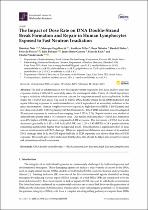| dc.identifier.citation | Nair, Shankari & Engelbrecht, Monique & Muller, Xanthene & Ndimba, Roya & Fisher, Randall & du Plessis, Peter & Bolcaen, Julie & Nieto-Camero, Jaime & de Kock, Evan & Vandevoorde, Charlot. (2019). The Impact of Dose Rate on DNA Double-Strand Break Formation and Repair in Human Lymphocytes Exposed to Fast Neutron Irradiation. International Journal of Molecular Sciences. 20. 5350. 10.3390/ijms20215350. | en_US |
| dc.description.abstract | first_pagesettingsOrder Article Reprints
Open AccessArticle
The Impact of Dose Rate on DNA Double-Strand Break Formation and Repair in Human Lymphocytes Exposed to Fast Neutron Irradiation
by Shankari Nair 1,2,*,Monique Engelbrecht 2,3,Xanthene Miles 2,Roya Ndimba 2,Randall Fisher 2,Peter du Plessis 2ORCID,Julie Bolcaen 2ORCID,Jaime Nieto-Camero 2,Evan de Kock 2 andCharlot Vandevoorde 2,*ORCID
1
Department of Radiochemistry, South African Nuclear Energy Corporation, Pretoria 001, South Africa
2
Radiobiology, Radiation Biophysics Division, Department of Nuclear Medicine, iThemba LABS, Cape Town 7131, South Africa
3
Department of Medical Biosciences, University of the Western Cape, Cape Town 7535, South Africa
*
Authors to whom correspondence should be addressed.
Int. J. Mol. Sci. 2019, 20(21), 5350; https://doi.org/10.3390/ijms20215350
Received: 16 September 2019 / Revised: 16 October 2019 / Accepted: 19 October 2019 / Published: 28 October 2019
(This article belongs to the Section Molecular Biology)
Download Browse Figures Review Reports Versions Notes
Abstract
The lack of information on how biological systems respond to low-dose and low dose-rate exposures makes it difficult to accurately assess the carcinogenic risks. This is of critical importance to space radiation, which remains a serious concern for long-term manned space exploration. In this study, the γ-H2AX foci assay was used to follow DNA double-strand break (DSB) induction and repair following exposure to neutron irradiation, which is produced as secondary radiation in the space environment. Human lymphocytes were exposed to high dose-rate (HDR: 0.400 Gy/min) and low dose-rate (LDR: 0.015 Gy/min) p(66)/Be(40) neutrons. DNA DSB induction was investigated 30 min post exposure to neutron doses ranging from 0.125 to 2 Gy. | en_US |

